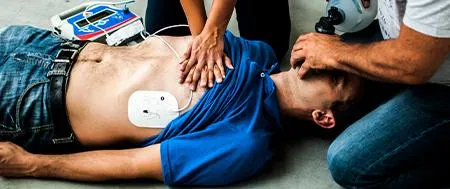Rutland First Aid Training
BLOG

What is a Defibrillator and how do I use it?
What is a Defibrillator?
A defibrillator is a life-saving machine that in some cases of cardiac arrest gives the heart an electric shock, this is called defibrillation and can save lives.
Why is a Defibrillator important?
Numerous studies have shown that if someone has a Cardiac Arrest in the Community with no defibrillator immediately available, there is only an 8% chance of them surviving; even if someone is performing great CPR on them.
Cardiac arrest is when the heart stops pumping blood around the body. The most common cause is an abnormal rhythm of the heart, known as ventricular fibrillation. This abnormal rhythm can occur when the heart muscle is damaged as a result of a heart attack or when insufficient oxygen reaches the heart.
When someone has a cardiac arrest, defibrillation needs to be prompt.
If a defibrillator is used within the first 3 minutes of someone stopping breathing, their chances of survival jumps from 8% to 74% and for each minute’s delay there is a 10% reduction in survival rate.
Hundreds of people are alive today entirely due to the prompt and appropriate use of a defibrillator.
Where do I find a Defibrillator?
Automatic External Defibrillators (AED) are now easily accessible at numerous locations including train and tube stations, shopping centres, dental and GP practices, sports grounds, leisure centres; and are available for the general public to use.
Do you know where your nearest one is? No, then there are a couple of applications that you can download and use to find your nearest one, one such application is GoodSam which is available on the appropriate app store.
Is a Defibrillator easy to use?
Yes they are, they are designed for anyone to be able to use. They provide you with a voice prompt of what to do.
Aren’t Defibrillators in a locked cabinet?
Yes they are. Once you have established that the casualty is unconscious and not breathing you will dial 999 or 112 to activate the ambulance service and start CPR. If you have an assistant then you can send them to fetch the nearest AED. The access code for the AED cabinet will be provided by the ambulance control centre.
What if I get it wrong when using the Defibrillator?
The machine analyses the casualty’s heart rhythm and will only allow a shock to be given if they are in a shockable rhythm. It is not possible to override this with an AED and if a shock is not advised you should continue to give CPR until the ambulance arrives.
The defibrillator will not allow you to shock someone if they don’t need it and it will prompt you throughout, including telling you to continue with CPR.
What do I do if a casualty becomes unconscious and is not breathing?
If a casualty becomes unconscious and is not breathing, start CPR – pushing hard and fast on the centre of the casualty’s chest. Try to get a defibrillator by sending a bystander to fetch the nearest one.
Once you have the defibrillator, open it up and it will start talking to you. Dry the casualty’s chest and then place the pads onto it as illustrated on the pads. Ideally someone should continue with CPR whilst another person is putting the pads onto the casualty’s chest and focuses on the defibrillator.
Ensure you know how to do to the best CPR possible – push down on the centre of the chest 5-6 cms, hard and fast. You are aiming for 100 – 120 chest compressions a minute.
Keep going and do not stop until the ambulance crew are there and ready to take over, or the casualty begins to regain consciousness.
Are you CPR and AED trained?
No – It goes without saying that they are indeed life saving but you also need to receive defibrillator training to ensure you are proficient with its use. This will not only further increase the chances of survival (from using the AED effectively) it will also make you more confident in its application and use.
Yes – then do something good and join the GoodSAM register. The East Midlands Ambulance Service (EMAS) was the first UK ambulance service outside of London to partner with GoodSAM (Smartphone Activated Medics); a web based alerting system and application that uses innovative technology to link a qualified lifesaver with a patient in cardiac arrest.
Defibrillator Questions we Regularly get asked or Myths Debunked
During our courses we hear many things said about Defibrillators and are asked many valid questions. Consequently, we have started to pull them together into this section to provide answers and to debunk myths surrounding defibrillators.
Q1: Can you use a defibrillator on a metal surface?
Many people believe that you can not use a defibrillator in any situation where the electrical shock might be transmitted however, this is NOT correct!
It is perfectly safe to use a defibrillator on a metal surface - providing that the pads have been applied correctly and the chest is dry, there is minimal risk.
Modern defibrillators modify the shock provided to the patient depending on their electrical resistance (i.e how big / small / fat / thin they are) so the shock delivered is not excessive.
Q2: I hear that using Defibrillators is complicated
Defibrillators talk to you and take you through step by step what you have to do to help save someone’s life. They are now available in so many public places and are easily accessible… Have a read of our blog on AEDs or a look at our AED video on youtube.
Q3: You have to be medically trained to use a Defibrillator
Wrong! They are available for use by the general public. Ideally you would have received training in how to give good quality CPR, as this will make a huge difference and give the patient the best possible chance of survival. Using the defibrillator is simple.
Q4: A Defibrillator jump starts the heart!
You are not jump starting the heart. Quite the reverse, you are stopping the heart to allow the heart’s natural backup system to take over and return it to normal sinus rhythm.
Q5: I can make things worse by using a Defibrillator
You cannot use a defibrillator if the casualty does not need it! It will not let you – so apply the pads, switch on the machine, listen to it and do what it asks you to do. Remember if someone is unconscious and not breathing you cannot make it any worse because, if you do nothing then they are dead.
Q6: I will kill them if I use a Defibrillator
The casualty is unconscious and not breathing – they are dead without good quality CPR and the use of an AED.
About Us
Rutland First Aid training provides a full suite of first aid training all tailored to your needs. We strongly recommend that everyone has some basic first aid skills, so why not attend one of our CPR and AED courses and know how to do CPR.. you could be the difference between your family member or even work colleagues survival
Rutland First Aid Training provides this information for guidance and it is not in any way a substitute for medical advice. Rutland First Aid Training is not responsible or liable for any diagnosis made, or actions taken based on this information
Hear what our first aid students have to say...
TESTIMONIALS


A really good training course, very professionally presented by Tracy. I’ve been on lots of training courses over the years and too often they can be soporific! Tracy is one of those rare training professionals who can deliver training and keep a person interested all day! Great course. Highly recommended!

Alan Eager
Google Review


Rutland first aid are professional yet kept the courses fun and interactive and use some very interesting props. As a driving instructor I wanted to be able to deal with any issues with my students but also any issues I may come across on the roads. Highly recommended.

James Dames
Google Review


Couldn't recommend Tracy and her team enough for a first aid course. Having to renew it every 3 years used to send me to sleep. Not with these guys! Professional, up to date and with lots of toys to play with, without the death by powerpoint.

Mike Gould
Google Review

Here at Rutland First Aid Training we strive to provide high quality, personalised, fun and informative first aid courses.
Our courses are recognised by HSE, Ofsted and follow ILCOR guidelines.
Short Cuts
Find what you are looking for:
Get In Touch
If you have any questions or would like to discuss your requirements in further detail, our team are always happy to assist you.
1 Old Station Yard, Whissendine Road, Ashwell, Rutland LE15 7SP
@ 2023 Copyright Rutland First Aid Training. All rights reserved.
Rutland First Aid Training is a trading name of Dive Rutland Limited. Company No: 9433835.




